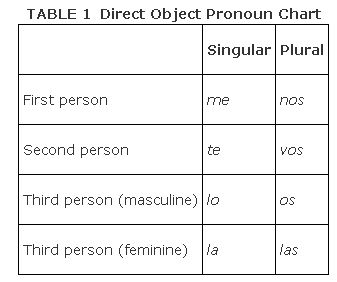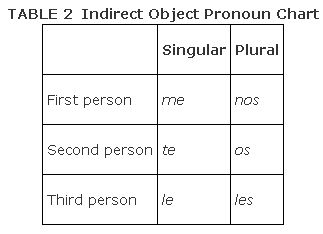If the noun you want to replace with a pronoun is serving as the direct object of the sentence, you must select the appropriate pronoun from the direct object case of pronouns. Table 1 lists the Spanish direct object pronouns. To determine which pronoun is appropriate, consider what pronoun you would have used if you were using a subject pronoun and select the direct object pronoun from the same spot in the chart below.

Because all nouns have a gender in Spanish, there is no need for a neutral pronoun like the English word “it.” The direct object pronoun lo literally translates as “him,” but, when used to replace a masculine noun that is an object, lo is translated as “it.” The direct object pronoun la means “her” but also means “it” when replacing a feminine noun that is an object. Just remember that lo, la, los, and las refer to both people and things.
Lo and la are also the direct object pronouns for Ud., so you must consider the gender of the singular “you” that you are replacing with a pronoun. Los and las are also the direct object pronouns for ustedes and will reflect the gender of the group of people that the plural “you” refers to.
It is especially confusing that the direct object pronouns la, los, and las look exactly like the definite articles la, los, and las. Just remember that when one of these words isn't followed by a noun, it is probably replacing one.
A direct object in English always follows the verb, even when the direct object is a pronoun. In Spanish, a direct object follows a conjugated form of a verb except when you turn the direct object into a pronoun. When you do this, the direct object pronoun is moved in front of the conjugated form of the verb. If the sentence is negative, the no or other negative word will precede the direct object pronoun. Watch what happens in the following pairs of sample sentences. The direct object is underlined in each sentence; in the second sentence, the direct object has been changed to a direct object pronoun and moved directly in front of the verb.
- Mateo invita a Gabriela. (Mateo invites Gabriela.)
- Mateo la invita. (Mateo invites her.)
- Maya escribe un libro. (Maya writes a book.)
- Maya lo escribe. (Maya writes it.)
- Anita mira a Martin. (Anita looks at Martin.)
- Anita lo mira. (Anita looks at him.)
- El jefe no invita a las mujeres. (The boss doesn't invite the women.)
- El jefe no las invita. (The boss doesn't invite them.)
- Benjamín tiene los discos. (Benjamin has the records.)
- Benjamín los tiene. (Benjamin has them.)
The above examples are all simple one‐verb sentences. In more complex sentences, direct object pronouns can be in different places.
Not every sentence has a direct object pronoun, but if it does, there's a good chance that it also has an indirect object. Except with specific exceptions, a sentence cannot have an indirect object unless it has a direct object.
Table 2 lists the indirect object pronouns.

Most of the Spanish indirect object pronouns look exactly like direct object pronouns except for the third person. The indirect object pronoun for the masculine “him” and the feminine “her” are exactly the same: The pronoun le is used as the indirect object pronoun for both genders.
Because the pronoun le is not very clear, a clarification can be placed either at the beginning of the sentence or after the verb to indicate the gender or even the specific person. To create a clarification, the preposition a is followed by a subject pronoun. Depending on the context, a él, a ella, or a usted can be used to clarify the pronoun le, or any noun can be used after the preposition a to specify exactly who is the indirect object.
- Salvador le da el libro a María.
- Salvador gives the book to María.
The pronoun les has the same problem, so if it is necessary to clarify the gender, do so by adding a ellos, a ellas, or a ustedes. It is common for the indirect object pronoun to be clarified by the actual noun that the indirect object replaces. Unlike the direct object, however, the indirect object pronoun is used even when the noun is stated.
- Santino les causó problemas a Mario y Andrea.
- Santino caused Mario and Andrea problems.
- Stacy nos escribe que la universidad es perfecta.
- Stacy writes to us that the university is perfect.
Whenever a sentence has both an indirect object and direct object pronoun, the indirect object is first and both follow the subject pronoun if stated. If the sentence is negative, the negative word is placed between the subject pronoun and the object pronouns.
- Ella nos la vendió cuando terminó su obra.
- She sold us it when she finished her painting.
- Sharkey didn't tell me it.
When there are two object pronouns together (indirect and direct) in the third person ( le, la, lo, los, las), the indirect object pronoun le or les changes to se.
- El artista mostró la pintura a los estudiantes. (The artist showed the painting to the students.)
- El artista la mostró a los estudiantes. (The artist showed it to the students.)
- El artista les mostró la pintura. (The artist showed them the painting.)
- El artista se la mostró (a ellos). (The artist showed them it.)
The following verbs are used idiomatically with an indirect object. As an example, let's look at gustar (me gusta, te gusta, le gusta, and so on). The form of the verb depends on what follows. Generally, the third person singular (él) form of the verb is used if followed by an infinitive or something singular. The third person plural is used when followed by something plural. Because these verbs are used with an indirect object, they're listed in the él form with various indirect object pronouns. They are listed in the present tense but can be used in any tense.

|
|
|
|
|
|
|
|
|
|
|
|
|
|
|
|
|
|
|
|
|
|
|
|
|
|
|
|
|
|
|
|
|
|
|
|
|
|
|
|
|
|
|
|
|
|
|
|
|
|
|
|
|